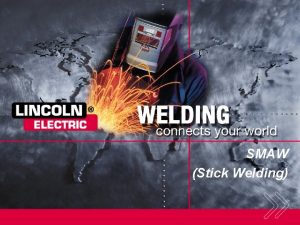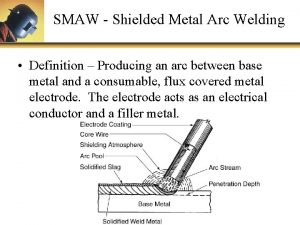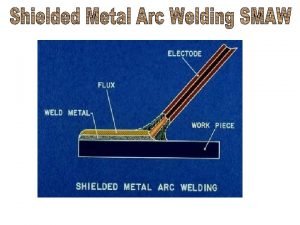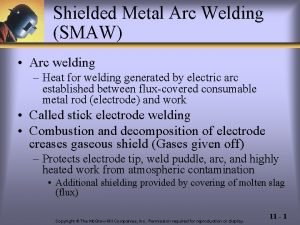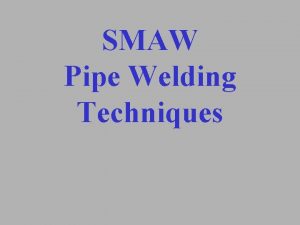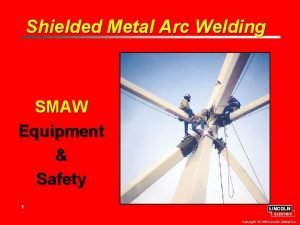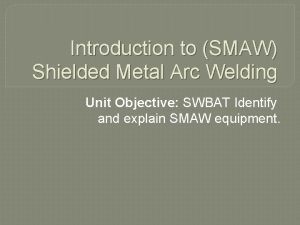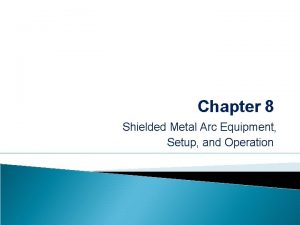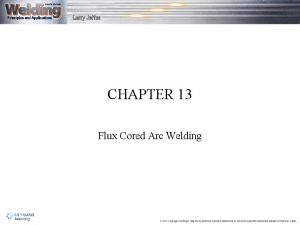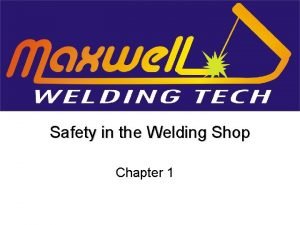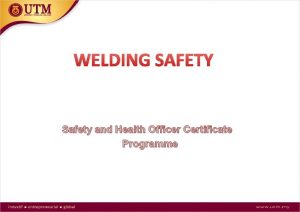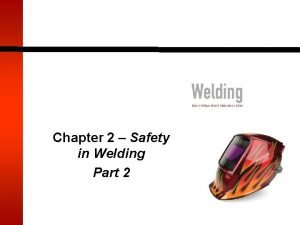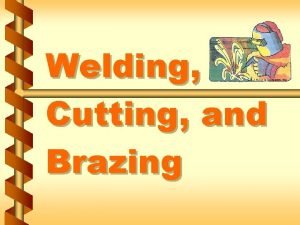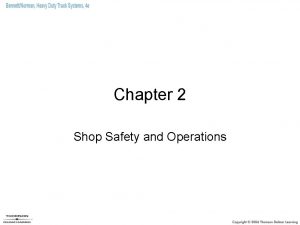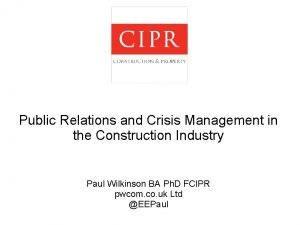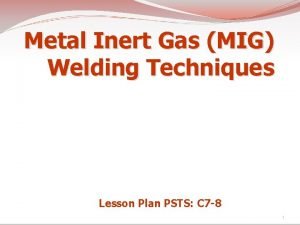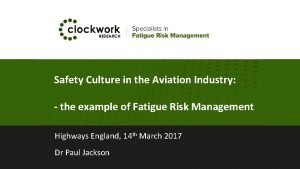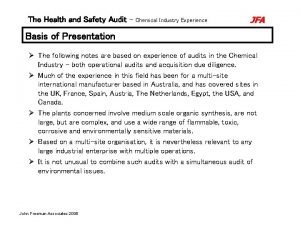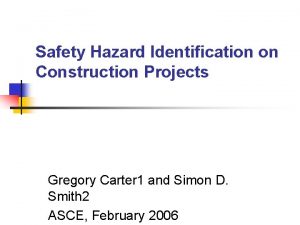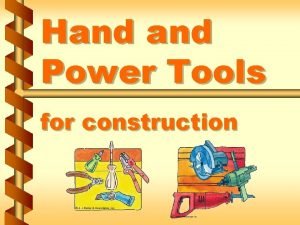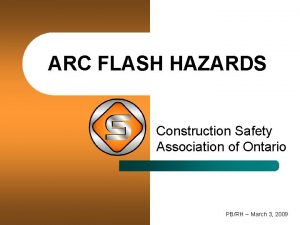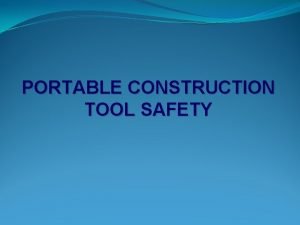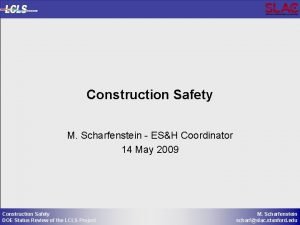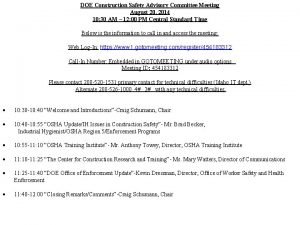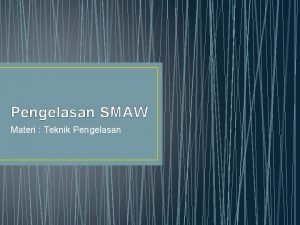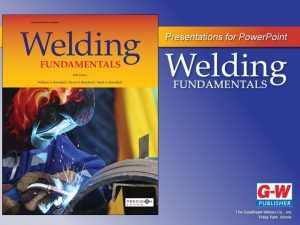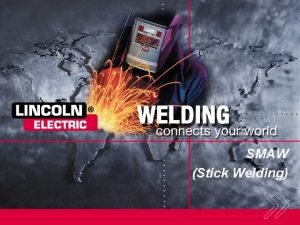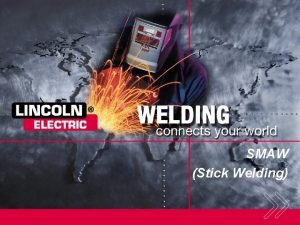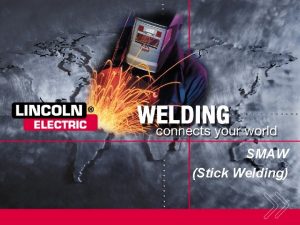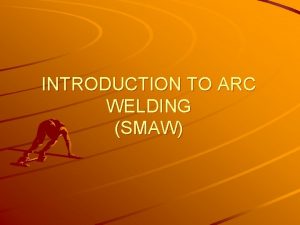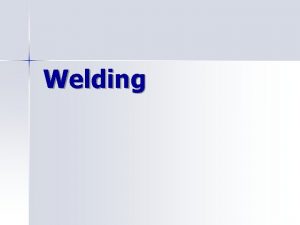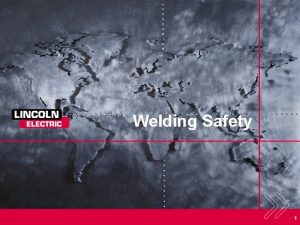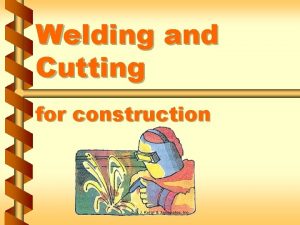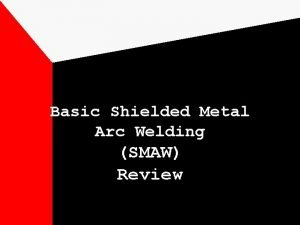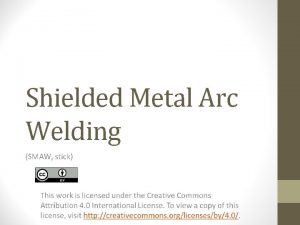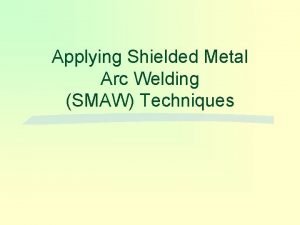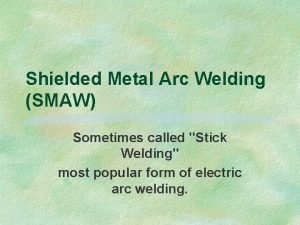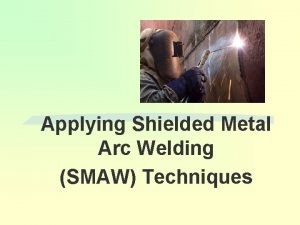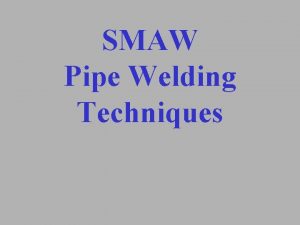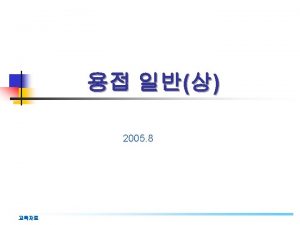Chapter 2 Welding Safety SMAW Welding Industry Construction


































- Slides: 34

Chapter 2 Welding Safety SMAW

Welding Industry Construction, Transportation, Manufacturing, Natural Resources SMAW Safety In Welding – Chapter #2

In electric arc welding, name four elements for which a welder operator requires protective clothing and equipment. 1) SPARKS 2) HEAT 3) LIGHT 4) FUMES SMAW Safety In Welding – Chapter #2

Examples of Personal Protective Equipment (PPE) used in welding. GOGGLES, HELMET, SAFTEY GLASSES, EAR PLUGS FLAME RETARDANT CLOTHING GLOVES SAFETY FOOTWARE SMAW Safety In Welding – Chapter #2

A welding arc gives off these 3 types of radiation: 1. Bright visible light 2. Non-visible infra-red radiation 3. Non-visible ultraviolet radiation SMAW Safety In Welding – Chapter #2

What causes eye flash? Looking at an unscreened arc without proper eye protection SMAW Safety In Welding – Chapter #2

Describe the effects of eye flash. A BURNING SENSATION AND AN IRRITAION SIMILAR TO THAT CAUSED BY SAND IN THE EYES A SUNBURN TO THE CORNEA LAYER ON YOUR EYE SMAW Safety In Welding – Chapter #2

Lens Shades Page 154 Lowest Shade Number Comfort Shade Number Conestoga College Recommended Under 60 7 - 8 60 - 160 7 10 10 - 12 160 - 250 10 12 11 - 13 Above 250 11 14 13 -14 Welding lens shade is selected based on welding amperage – WHY? SMAW Safety In Welding – Chapter #2

What hazards are associated with slag? 1) WHEN FIRST DEPOSITED IT IS VERY HOT 2) WHEN COOL IT BECOMES SOLID AND HARD CARE MUST BE TAKEN WHEN CHIPPING OFF THE SLAG MAKE SURE THE SLAG DOES NOT STRIKE YOU OR SOMEONE ELSE Arc Welding Safety – Unit #8

Burns Ø Classifications ◦ First-degree burns Skin surface is reddish, tender, and painful Do not involve broken skin Immediate treatment: cold water or compress ◦ Second-degree burns Skin is severely damaged Result in blisters and possibly breaks Immediate treatment: cold water or compress SMAW Safety In Welding – Chapter #2

Burns FIGURE 2 -1 First-degree burn—only the skin surface (epidermis) is affected. © Cengage Learning 2012 FIGURE 2 -2 Second-degree burn—the epidermal layer is damaged, forming blisters or shallow breaks. © Cengage Learning 2012 SMAW Safety In Welding – Chapter #2

Burns ØClassifications (CONT’D. ) Third-degree burns Skin surface appears white or charred Immediate treatment: cold cloth or cool water on burns of the face, hands, or feet and cover ◦ Burns caused by light Types of light: ultraviolet, infrared, and visible Ultraviolet light waves: most dangerous SMAW Safety In Welding – Chapter #2

Burns FIGURE 2 -3 Third-degree burn—the epidermis, and the subcutaneous layers of tissue are destroyed. © Cengage Learning 2012 FIGURE 2 -4 Portable welding curtains. Frommelt Safety Products SMAW Safety In Welding – Chapter #2

General Work Clothing Should minimize burn chances ◦ Wool is the best choice ◦ All-cotton is a good second choice ◦ Stay away from synthetic material – burn/melt stick Guidelines ◦ Shirts: long-sleeved, collared, long enough to tuck in, and flapped pockets ◦ Pants: cover top of boots and without cuffs ◦ Boots: high tops and steel toes ◦ Caps: thick SMAW Safety In Welding – Chapter #2

Special Protective Clothing Includes: ◦ ◦ ◦ Hand protection: all-leather, gauntlet-type gloves Body protection: full leather jackets and capes Waist and lap protection: bib or full aprons Arm protection: full- or half-sleeves Leg and foot protection: leather pants or leather aprons with leggings SMAW Safety In Welding – Chapter #2

SMAW Safety In Welding – Chapter #2

Respiratory Protection Equipment should be certified by NIOSH, CSA (National Institute for Occupational Safety & Health, Canadian Standards Association etc) ◦ ◦ ◦ ◦ Air-purifying respirators Atmosphere-supplying respirators Demand respirators Positive pressure respirators Powered air-purifying respirators Self-contained breathing apparatuses Supplied-air respirators Filtering face piece SMAW Safety In Welding – Chapter #2

Respiratory Protection FIGURE 2 -14 Typical respirator for contaminated environments. The filters can be selected for specific types of contaminant. SMAW Safety In Welding – Chapter #2

Ventilation Actual welding area ◦ Should be outside or well-ventilated Natural ventilation is the best Forced ventilation may be required Forced ventilation ◦ Required in small shops or shops with a large number of welders ◦ May be general or localized Using fixed or flexible exhaust pickups SMAW Safety In Welding – Chapter #2

SMAW Safety In Welding – Chapter #2

Electrical Safety Electric shock ◦ Can cause injuries and even death Proper precautions must be taken SMAW Safety In Welding – Chapter #2

What are the four rules to help prevent electric shock? 1) TURN OFF MACHINES WHEN NOT IN USE 2) WEAR GLOVES WHEN HANDLING EQUIPMENT 3) KEEP EQUIPMENT DRY 4) BEWARE OF DAMPNESS OF ANY KIND SMAW Safety In Welding – Chapter #2

Ear Protection Ear protection ◦ Earplugs ◦ Disposable ear plugs available in shop to all students SMAW Safety In Welding – Chapter #2

General Safety & House Keeping Lighters State of Equipment Handling Material Work Area Tidiness SMAW Safety In Welding – Chapter #2

What safety precautions must be taken with regards to matches or fuel lighters? DO NOT CARRY MATCHES OR LIQUID FUEL LIGHTERS IN YOUR POCKET SMAW Safety In Welding – Chapter #2

What action should be taken when welding and cutting equipment appears to be defective? REPORT IT IMMEDIATELY TO YOUR INSTRUCTOR SMAW Safety In Welding – Chapter #2

How does one test for heat radiation of a piece of metal? BY HOLDING THE PALM OF THE HAND, ABOVE THE PIECE OF METAL SMAW Safety In Welding – Chapter #2

Waste Material Disposal Welding shops generate waste materials ◦ Mostly scrap metal ◦ All scrap metal can be easily recycled Good for the environment Source of revenue ◦ Hazardous waste disposal Consult local, provincial, and federal regulations SMAW Safety In Welding – Chapter #2

When should an electrode stub be discarded? AT APPROXIAMETELY 50 MM (2 INCHES) SMAW Safety In Welding – Chapter #2

Work Area Should be kept picked up and swept clean SMAW Safety In Welding – Chapter #2

Fire Protection Fire: constant danger to the welder Fire watch ◦ Provided by anyone who knows how to sound the alarm and use a fire extinguisher Fire extinguishers ◦ Type A, B, C, and D (type C best for weld shop) ◦ Should be located near materials ◦ Work by breaking the fire triangle of heat, fuel, and oxygen End Chapter # 1 SMAW Safety In Welding – Chapter #2

Points to Remember Welding fumes should be ventilated away from the person welding, not across the welder's face. Avoid arc flash; Report all eye flashes Electrode stubs and slag are sources of danger Welding fumes are harmful. Work in well-ventilated areas to prevent suffocation or fume sickness. Never wear synthetic fibre clothing or weld with flammables in your pocket. Synthetic fibres’ are highly flammable. If ignited by a welding spark, flammable (i. e. matches, butane lighters, fuel sticks, etc. ) could cause serious burns. Avoid electrical shock. Make certain that the electrode holder and all electrical connections and cables are properly insulated. SMAW Safety In Welding – Chapter #2

Points to Remember cont’d. Check to see that the welder is properly grounded. Never weld in damp locations because of the shock hazard. Gloves help to insulate against possible shock. Keep the cables from coming in contact with hot metal and sharp edges. Do not drive over cables. When welding, avoid wrapping electrode cables around your body. To reduce fatigue, use both hands for welding. Handle hot metal with pliers or tongs. Submerge hot metal completely in water to prevent steam burns. Do not allow electrode to stick. SMAW Safety In Welding – Chapter #2

Points to Remember cont’d. If the electrode sticks, cut off the switch, allow electrode to cool, and then break it loose with your gloved hand. Never allow the hot electrode or electrode holder to touch bare skin. Avoid letting the electrode touch the grounded cable. Remove hot metal from the work area when you are finished welding to prevent burns to others. Use a welding table to hold welds securely in place. Clamps and vices can be used to hold odd-shaped work or field work. Securing work will also prevent injury from accidental dropping of metal on your feet or body SMAW Safety In Welding – Chapter #2
 Smaw welding lesson plans
Smaw welding lesson plans Smaw meaning
Smaw meaning Ppe of smaw
Ppe of smaw Parts of a welding process (smaw)
Parts of a welding process (smaw) Arc length welding definition
Arc length welding definition Smaw pipe welding
Smaw pipe welding 00101-15 basic safety
00101-15 basic safety Basic safety construction site safety orientation
Basic safety construction site safety orientation Smaw safety
Smaw safety Tools in smaw
Tools in smaw Smaw equipment set up
Smaw equipment set up Chapter 13 smaw horizontal position
Chapter 13 smaw horizontal position Welding shop safety assessment
Welding shop safety assessment Welding safety quiz
Welding safety quiz Chapter 2 welding safety
Chapter 2 welding safety Welding fire safety
Welding fire safety Chapter 1 safety in the welding shop
Chapter 1 safety in the welding shop Impact of gst on construction industry
Impact of gst on construction industry 2nd page
2nd page Accidents in construction industry
Accidents in construction industry Chapter 3 joint design and welding terms
Chapter 3 joint design and welding terms The welding process by metal inert-gas (mig) welding is
The welding process by metal inert-gas (mig) welding is Safety culture in aviation industry
Safety culture in aviation industry Safety audit in chemical industry
Safety audit in chemical industry Gregory carter
Gregory carter Construction tool safety
Construction tool safety Arc flash training ontario
Arc flash training ontario Compactor hazards
Compactor hazards Construction safety system
Construction safety system Concrete buckets osha
Concrete buckets osha Construction safety
Construction safety Health and safety executive construction
Health and safety executive construction Stringer bead in flat position
Stringer bead in flat position Pengertian las smaw
Pengertian las smaw Smaw electrode designation
Smaw electrode designation
